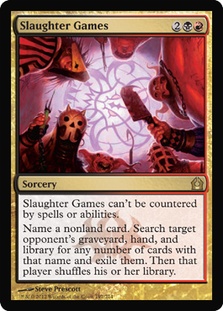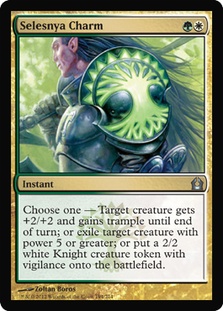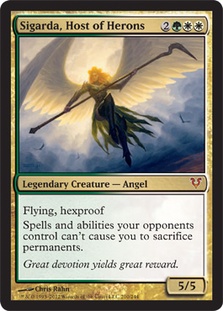As someone who has done nothing but observe Standard since the recent rotation, it’s been amusing to watch as perspectives have shifted about the format. We went from “Zombies is too good! How can anyone ever beat Zombies?” to “Thragtusk is too good! How can anyone ever beat Thragtusk?” within a matter of a few short weeks. The tone of public opinion about a format always has to be taken with a grain of salt, but it’s a pretty dramatic shift from Gravecrawler to Thragtusk as public enemy number one.
We’ve moved from people complaining that the format is too fast to people complaining that the format is too “grindy.” I’m not really sure what that means exactly. Do people not enjoy games that involve playing a lot of turns and making lots of decisions? It’s not like these are draw-go decks, either. There are a lot of creatures and spells being played on both sides of the table, and eventually someone is able to seize and maintain an advantage to win. Frankly, that sounds like awesome Magic to me.
I’ve even heard people suggest that Thragtusk should be banned. Seriously? Thragtusk is a five casting cost value creature. Yes, it’s a very good card and maybe the best card in Standard, but it’s hardly the sort of thing that creates massively negative play experiences. In fact, a format in which a card like Thragtusk is good is exactly the kind of format I wish Magic had all the time! You mean I can play a five casting cost creature that does nothing but attack and block and generate marginal value—and that’s one of the best things I can be doing? Sign me up! Â
I mean hell—compare Thragtusk to Primeval Titan. Primeval Titan cost one more mana than Thragtusk and essentially ended the game on the spot. What percentage of games actually lasted more than a turn or two after a Primeval Titan resolved? I’d rather have “grindy” games that go on for a while as players exchange punches and try to eke out advantages than games where one player essentially wins immediately because they played a Titan.
It’s funny to me that people were so taken aback by the failure of Zombies to remain a major player in the format after the first few weeks. Who could have predicted that rather than Gravecrawlers and Diregraf Ghouls we’d have a world full of midrange creatures like Thragtusk, Olivia Voldaren, and Thundermaw Hellkite? Well, anyone who read my first article about Return to Ravnica spoilers, that’s who. Magic is all about context, and while Zombies may have been where you wanted to be in Delver land, they don’t match up nearly as well against what the new world order has to offer.
That new world order is already shifting, though, and quickly. The early weeks of the format were full of Zombies and decks built to beat them, and after the Zombies disappeared (much like in Season 2 of The Walking Dead), we had Thragtusks clashing everywhere we looked. So now the question is how to beat the Thragtusk decks.
The major players in Standard right now appear to be Reanimator, Jund, Bant Control, and various flavors of U/W Midrange, with and without red. In recent weeks, the blue decks have been on the rise, no doubt because people started realizing that Thragtusk costs five mana and five mana creatures are pretty easy to stop with countermagic if you try. As much as people may claim that Wizards is doing everything to ensure the death of blue as a color in Magic, it certainly always seems to come around and make its presence felt again, doesn’t it?
This is the Standard format as I saw it when I started my testing for GP Charleston and GP San Antonio last week:
Creatures (15)
Lands (24)
Spells (21)

Creatures (12)
Planeswalkers (6)
Lands (25)
Spells (17)

Creatures (15)
- 1 Olivia Voldaren
- 1 Griselbrand
- 1 Restoration Angel
- 1 Craterhoof Behemoth
- 4 Thragtusk
- 4 Angel of Serenity
- 3 Centaur Healer
Lands (23)
Spells (22)

Creatures (11)
Lands (25)
Spells (24)

Creatures (12)
Lands (23)
Spells (25)
- 2 Dissipate
- 4 Unsummon
- 1 Rewind
- 2 Syncopate
- 3 Think Twice
- 2 Essence Scatter
- 2 Runechanter's Pike
- 4 Thought Scour
- 4 Azorius Charm
- 1 Sphinx's Revelation
Sideboard

A pretty wide range, isn’t it? Yes, there are a bunch of decks with Thragtusk, but they’re hardly “Thragtusk decks.” And some of the decks without Thragtusk are the ones that have done the best recently, which ought to suggest that the sky-is-falling cries about how Thragtusk is somehow dominating the format are without much merit.
So how do you beat Thragtusk? The answer is that you need to construct your deck such that the card isn’t as good against you. That may sound obvious, but many people seem to be having trouble making it happen. Thragtusk is at its best in matchups where everything about it matters: the 5/3 body on the ground, the five life you get when it comes into play, and the 3/3 it leaves behind when it dies. If your game plan is to race with midrange ground creatures—you know, like the Lotleth Trolls and Dreg Manglers of the world that people were so sure would have turned us all into brain-eaters by now—you’re probably not going to do so well. If you want to beat Thragtusk, you want to go over the top of it, either literally or figuratively.
Thundermaw Hellkite didn’t get a lot of love when it first showed up, but boy is it the Dragon for the job right about now. Not only does it fly over top of Thragtusk when the ground is all clogged up, but it takes huge bites out of the opposing life total as it’s doing so. Not only that, but with the departure of cards like Go for the Throat and Doom Blade, we’ve seen a shift toward sorcery speed removal like Detention Sphere and Dreadbore. Being able to get a hit in—either to the opponent’s life total or to take down a planeswalker—before your opponent has a chance to kill your Dragon is a big deal.
Speaking of planeswalkers, how good is Garruk, Primal Hunter right now? In a world of grindy ground stalls, drawing extra cards is huge, especially in the big chunks that Garruk is capable of. As tempting as it might be to keep pumping out Beast tokens and attempt to go ultimate, it’s important to remember that Dreadbore is a thing, so you’ll frequently just want to cash in your planeswalker for a new hand. While Harrison Deemer’s Jund deck above relies on Underworld Connections and Rakdos’s Return for its card advantage, I’m much more excited by the Garruk-heavy builds that noted Brazilian Magic Online player Batutinha has been playing online.
Creatures (11)
Planeswalkers (3)
Lands (24)
Spells (22)

The Deathrite Shamans and Slaughter Games in Batutinha’s sideboard are clearly aimed at combating the Reanimator strategies and other decks looking to overpower Thragtusk with Angel of Serenity. Angel has proven to be an exceptionally powerful card, and its popularity is certainly one of the contributing factors in the rise of blue decks since it’s much easier to stop it from entering the battlefield than it is to deal with it once it hits. Slaughter Games looks to put an end to all of those shenanigans once and for all. While I’m typically not a fan of that sort of effect against non-combo strategies, this is actually one place I can see the rationale for it since this deck is generally well positioned to beat Angel decks so long as they don’t actually play Angel.
Slaughter Games is also an excellent tool against control decks leveraging Sphinx’s Revelation, as per Sam Black advice in his most recent article. Many people dismissed Sphinx’s Revelation as another unimpressive mass card draw effect like Blue Sun’s Zenith; after all, it has the same overall converted mana cost and close to the same effect. Close isn’t the same, though, and remember what we said at the beginning: context matters. Blue Sun’s Zenith existed first in a world of Caw-Blade and then in a world of Delver. Aggro-control decks with Mana Leak certainly don’t create environments conducive to paying a ton of mana to do something other than win the game.
On top of that, there is a substantive difference between drawing five cards for eight mana and drawing the same amount of cards for the same mana and also gaining five life. In the first case, if you’re being attacked for lethal—that’s it, you’re dead, and the game is over. In the second, you not only get to stay alive thanks to the life gain, but you also get to untap with a grip full of cards. That’s huge. Sphinx’s Revelation provides two important things that control strategies want: card advantage and the time to leverage it. Any time life gain comes attached to an effect that advances your ability to win the long game it’s worth a second glance, and Sphinx’s Revelation certainly passes the test.
That’s the reason that Trostani, Selesnya’s Voice caught my eye during spoiler season. The combination of populate plus the life gain trigger is extremely powerful at allowing you to win the long game because they feed off one another. I figured that Trostani was exactly the sort of card that could win Thragtusk wars and put together this deck, which was very similar to one of the first sketches I made for the format. Note that, as is typical for my initial lists, the sideboard is more a smattering of ideas rather than a cohesive plan.
Creatures (30)
- 3 Borderland Ranger
- 4 Arbor Elf
- 4 Avacyn's Pilgrim
- 4 Restoration Angel
- 1 Sigarda, Host of Herons
- 4 Thragtusk
- 4 Loxodon Smiter
- 3 Trostani, Selesnya's Voice
- 3 Armada Wurm
Planeswalkers (2)
Lands (24)
Spells (4)

Initially, this deck performed incredibly well. I played against a huge swath of aggressive decks and repeatedly trounced them. Trostani was just as powerful as I’d imagined, allowing me to crawl back into games I would almost certainly have lost. It was particularly amusing that my playtesting seemed to coincide with the rise in popularity of Mono-Red Aggro. I kept running into opponents who were trying to kill me with the likes of Rakdos Cackler, Gore-House Chainwalker, and Ash Zealot. While I can respect the effectiveness of Pyreheart Wolf at pushing damage past a single Thragtusk, it’s much less effective at dealing with that same Thragtusk backed up by Trostani, Restoration Angel, and Armada Wurm. A non-trivial number of my games ended with my opponent conceding when the life gain trigger from my second 5/5 of the turn went on the stack. They wouldn’t even let me populate!
While the deck was quite potent against aggressive decks, it was much less effective against more controlling strategies. Opposing Jund decks proved to be problematic, unsurprisingly due to Olivia Voldaren. Olivia could quickly get out of hand at any point in the game, and I couldn’t always rely on having a Selesnya Charm to keep her under control. Similarly, the deck wasn’t quite fast enough to compete with the decks that went bigger. While Trostani and Armada Wurm and friends represent an extremely potent late game, they can still get trumped by Angel of Serenity or Craterhoof Behemoth before they can end the game. Overall, the deck felt like it was trying to do too many different things. Cards like Loxodon Smiter play for the early game, while Trostani wants to go long.
My inclination is that it’s better to try to speed the deck up rather than go bigger, but I want to try a more token oriented populate direction as well. I don’t like the aggressive G/W decks that have been floating around. I’m not terribly impressed by Silverblade Paladin or Rancor. Paladin asks for too much to go right for him to be effective. Not only do you have to get double white mana early—which can be difficult when you want to play enough turn 1 green sources to consistently play your mana creatures—but you also have to keep him paired with something. There are so many potential blowouts you can walk into with Silverblade Paladin thanks to Unsummon, Searing Spear, Azorius Charm, etc. I’ve definitely Selesnya Charmed away opposing Wolfir Silverhearts and eaten the now-unpaired Paladin on multiple occasions, and I don’t particularly want that to happen to me.
Rancor is similarly vulnerable to blowouts and really doesn’t even seem that good to me. Rancor was awesome when it was first printed because the relative size of creatures was so small. If you played a Wild Dogs and Rancored it up, you were doing twice as much damage! But if you’re putting Rancor on a Loxodon Smiter or a Sublime Archangel or something, you’re getting much less relative impact from it. Yes, Rancor gives your creature trample, but unless you’re connecting with something huge already, that’s rarely that big a deal. The risks you expose yourself to in order to use Rancor (especially now that blue decks are rising in popularity) just don’t seem worth it. If we see a spike in the number of Lingering Souls flying around? Sure, we want a way to trample over those. But in a world of Thragtusks and Olivias and Unsummons and the like? I’m much less excited about the idea.
The cards I really did like in my G/W deck—besides the obvious candidates—were Selesnya Charm and Sigarda, Host of Herons. Selesnya Charm does so many things, and all of them are pretty solid effects. With Angel of Serenity and Thundermaw Hellkite both significant players in the format, an instant speed two cost removal spell that can kill either of them is a pretty good card in its own right. But it’s a removal spell that has multiple proactive uses. Keep in mind that the +2/+2 mode gives trample, which is especially relevant in a world of Restoration Angels. I’ve had multiple opponents attempt to block a big creature with a Thragtusk and Blink it out, only to find themselves suddenly taking much more damage than they expected when they now have zero toughness facing down a trampler.
Sigarda is obviously pretty awesome against the Jund decks chock full of spot removal, but it’s also pretty sweet that it gives you a body that your opponent can’t remove with Angel of Serenity. While Selesnya Charm gives you an answer to the Angel keeping your team in purgatory indefinitely, it doesn’t mitigate the enormous tempo swing that getting your creatures returned to your hand can be. Sigarda gets to sit in play and keep the pressure on once you get the Angel out of the way.
My testing is still very much a work in progress—I haven’t nailed anything down just yet. Here are some thoughts on a bunch of cards that I’ve tried or considered:
Thalia, Guardian of Thraben — There are a lot of spell heavy decks out there right now, which makes Thalia pretty attractive. If you’re playing Thalia, it’s important that the rest of your deck applies enough pressure to make her mana denial effect significant because even those decks hit hard by her still have bodies that get in her way. Restoration Angel in particular makes it annoying to attack.
Ground Seal — Stops Snapcaster Mage, Unburial Rites, Deathrite Shaman, and the graveyard return effect on Angel of Serenity all while drawing you a card.
Gavony Township — Not what it used to be. Losing Blade Splicer and Huntmaster (in this deck at least) makes it much worse. Considering cutting it for Caverns.
Plummet — Thundermaw Hellkite, Restoration Angel, Angel of Serenity, and Dungeon Geists all die to Plummet at instant speed. Not sure if it’s too narrow, but I’ve liked it so far.
Sundering Growth / Rootborn Defenses — Haven’t been impressed so far. Hard to get populate value, and sometimes Defenses runs into Terminus and is very sad.
Yeva, Nature’s Herald — Why has no one tried this yet? A 4/4 body for four mana matches up pretty well with the players in the format, and there are a lot of sweet creatures to play at instant speed, like Silverheart.
Cavern of Souls — Expect a resurgence. Blue is back, which means Cavern will be too. I’ve already done quite a few Gatherer searches by creature type. Angel is going to be a big one.
Faith’s Shield — Another important card for people who want to play big creatures in a world with so much spot removal. Remember that it protects permanents. Giving your Garruk protection from Dreadbore can be game winning.
Like I said, it’s a work in progress. I’m going to be playing a ton of Standard over the next few weeks to prepare for the upcoming GPs, so I’ll have more steps in the process to share with you as time goes on. If I can get my schedule to work things out properly, I’ll even have a Standard video for you next week too! No promises, but I’m going to do what I can.
Until next time,
bmk




